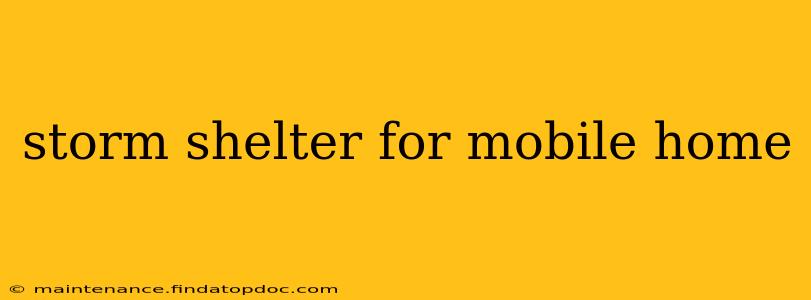Mobile homes, due to their lightweight construction, are particularly vulnerable during severe weather events like tornadoes and hurricanes. Protecting your family requires a robust safety plan, and a dedicated storm shelter is a crucial component. This guide explores the options and considerations for installing or acquiring a storm shelter specifically designed for mobile home safety.
What are the best types of storm shelters for mobile homes?
Several options exist for storm shelter installations or additions for mobile homes, each with its pros and cons:
-
Above-Ground Shelters: These prefabricated shelters are installed above ground, often anchored to a concrete slab. They offer quick installation and are relatively less expensive than in-ground options. However, they might require more space and may not offer the same level of protection as in-ground shelters, particularly against larger debris.
-
In-Ground Shelters: These shelters are partially or fully buried underground, offering superior protection from high winds and flying debris. However, they require more extensive excavation and installation, making them more expensive and time-consuming to install. They also require careful consideration of water drainage to prevent flooding.
-
Basement Shelters (if applicable): If your mobile home has a basement, reinforcing it to storm shelter standards can be a cost-effective option. This often involves strengthening walls, adding a reinforced door, and potentially adding additional shielding.
-
Interior Room Reinforcement: While not a dedicated storm shelter, reinforcing a well-built interior room (often a bathroom or closet) can provide a small degree of increased safety. This typically involves strengthening walls and doors with reinforced materials. However, this is generally considered a less effective solution than a dedicated shelter.
How much does a storm shelter for a mobile home cost?
The cost of a storm shelter varies greatly depending on several factors, including the type of shelter (above-ground vs. in-ground), its size, features (e.g., ventilation, anchoring), and installation costs. Above-ground shelters are generally less expensive, with prices ranging from a few thousand dollars to upwards of $10,000. In-ground shelters can cost significantly more, ranging from $10,000 to $30,000 or more. Always obtain multiple quotes from reputable installers before making a decision.
How do I choose the right size storm shelter for my family?
The size of your storm shelter should accommodate everyone in your household comfortably, plus some additional space for supplies. Consider the number of people you need to shelter, and allow for enough room to sit or lie down without feeling cramped. Manufacturers provide size specifications for their shelters, and you should carefully choose one that meets your family's needs.
Where is the best location to place a storm shelter for a mobile home?
The ideal location for a storm shelter depends on the type of shelter. Above-ground shelters should be placed on a level, stable surface, away from potential hazards like overhanging trees or power lines. In-ground shelters require careful consideration of soil conditions and drainage to prevent flooding. Proximity to the mobile home is a major convenience factor, minimizing the distance you need to travel during an emergency. Consulting with a professional installer is crucial for proper placement.
Is it possible to build my own storm shelter for a mobile home?
Building your own storm shelter is generally not recommended unless you possess significant construction experience and expertise in structural engineering. Storm shelters must meet strict safety standards to withstand severe weather, and improper construction could compromise safety. Using pre-fabricated kits might seem like an option to reduce costs, but it's crucial to ensure they are engineered to meet the necessary safety codes.
What are the building codes and regulations for storm shelters in mobile homes?
Building codes and regulations for storm shelters vary by location. It's essential to check with your local building department to understand the specific requirements in your area before beginning any installation. These regulations typically cover aspects like shelter construction, anchoring, and location requirements.
Are there any financial assistance programs available for storm shelter installation?
Some government agencies and non-profit organizations offer financial assistance programs for individuals and families to install storm shelters, particularly in areas prone to severe weather. Check with your local emergency management agency or FEMA (Federal Emergency Management Agency) to learn more about potential assistance programs in your area. These programs often have specific eligibility criteria and application processes.
By carefully considering these factors and prioritizing safety, you can ensure your mobile home offers a safe haven for your family during severe weather events. Remember to always consult with professionals for guidance and to ensure compliance with all relevant building codes and regulations.
